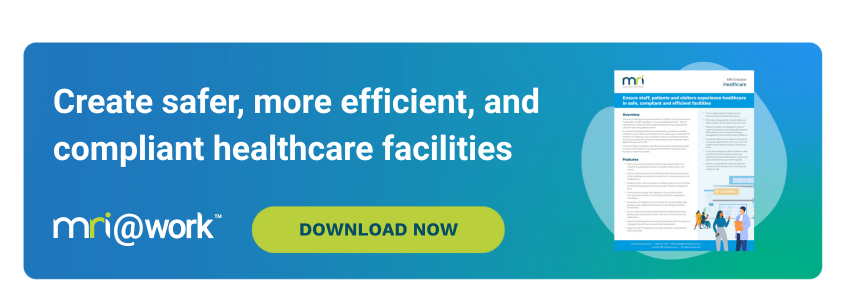
The healthcare sector across Australia and Asia Pacific is under mounting pressure to modernise its buildings, workspaces and infrastructure to meet evolving industry standards.
Owners and investors are capitalising on sector growth by prioritising integrated, technology-enabled, and environmentally responsible hospitals, medical centres, clinics, and allied health facilities. Meanwhile, occupiers are demanding operational efficiency, spatial flexibility, and compliant environments that support both staff and patients.
MRI Software’s 2025 Voice of the Facility Manager report shares insights from a recent survey of Facilities Management (FM) professionals in Australia and New Zealand, highlighting their current and future priorities. This eBook highlights the report’s four key findings for the healthcare industry: the measured pace of digital transformation, the challenges of ageing infrastructure, the need for increased focus on sustainability and the importance of asset adaptability.
1. Taking cautious steps toward digital transformation
Healthcare facility managers report a distinctive technology profile: the reliance on spreadsheets versus software is more common here than in other sectors. Survey findings indicate a slower pace of technology adoption in this field, with many FM professionals showing minimal engagement with new or emerging technology-enabled solutions.
A cautious approach to the uptake of new digital tools is understandable. Healthcare environments are complex, highly regulated and risk-averse. Patient safety, operational continuity and compliance require technological change to be carefully vetted and implemented.
However, spreadsheet dependence comes with operational challenges that include:
- Fragmented information management and data silos that isolate critical facility information. This can be particularly problematic during compliance audits or emergency response situations.
- Resource-intensive processes like manual data entry that consume valuable staff time and are prone to human error in an industry where accuracy is paramount.
- Reliance on point-in-time snapshots rather than continuous, real-time monitoring for proactive maintenance and efficiency improvement opportunities.
As healthcare organisations continue to face mounting pressures to boost operational efficiency, reduce manual workloads, and ensure rigorous compliance, the case for purpose-built facility management software becomes increasingly compelling.
2. Coping with ageing equipment and infrastructure
The survey highlights that “the demands of managing ageing equipment” rank as a higher challenge in healthcare than in other sectors. Hospitals and clinics often operate with legacy infrastructure, including HVAC systems, medical gas lines and critical power supplies that are expensive to upgrade and maintain.
The consequences for healthcare facilities include:
- Higher energy consumption and operational inefficiencies.
- Increased maintenance costs and the risk of unplanned downtime.
- Compliance risks, as older systems may fall short of evolving standards.
Budget constraints and the cost of upgrades compound these challenges and leave many facilities financially stretched. This is where proactive, data-driven maintenance and lifecycle planning become important. Supported by FM software, they can be critical ways to mitigate risks and extend asset life.
3. Meeting the mandate for net-zero targets
According to the report, many healthcare facility managers consider achieving net zero a challenge rather than an opportunity. This is not surprising as hospitals operate around the clock, are heavy users of energy and water and have to prioritise patient outcomes above all else. All this makes decarbonisation complex, with energy upgrades involving extensive risk mitigation and careful planning.
Findings are reinforced by the Australian Commission on Safety and Quality in Healthcare’s report, which concludes that the nation’s healthcare service providers need to dramatically scale up sector-wide action in sustainability.
While many Australian health services actively pursue sustainable healthcare goals in building design, energy use, waste management and procurement, standardised processes and reporting metrics are lacking.
Key pressures include:
- The need for comprehensive, phased capital works to upgrade legacy assets.
- Balancing sustainability with ongoing infection control and patient safety initiatives.
- The implementation of state-level net-zero targets (NSW Health, for example, aims to achieve net zero by 2050 as part of a proposed Net Zero Roadmap).
As the industry progresses its net-zero strategies, better FM services and solutions will be an indispensable part of tracking energy use, identifying efficiency opportunities, and supporting compliance with sustainability mandates.
4. A demand for flexible and resilient infrastructure
The report reveals that “adoption of more flexible and resilient infrastructure” is a top area of evolution for facility managers in healthcare, ranking significantly higher than in the broader FM market.
In this sector, flexibility and resilience aren’t just buzzwords; they’re must-haves in environments that need to adapt to surges in demand during pandemics or health crises, new models of care, and evolving regulatory requirements.
Modern healthcare facilities are embracing new approaches like:
- Modular construction and off-site fabrication for rapid expansion.
- Digital twins and smart systems for real-time monitoring and scenario planning.
- Design strategies that enable spaces to be reconfigured with minimal disruption.
FM software underpins these efforts, enabling facility managers to plan, monitor, and adapt their assets for both immediate and future needs.
The case for smarter facilities management solutions in healthcare
Healthcare is at a crossroads, balancing the demands of legacy infrastructure, regulatory complexity, sustainability targets and the need for operational agility.
Facility managers are ready for tools that help them move from reactive firefighting to proactive, data-driven decision-making through:
- Streamlined compliance and maintenance management.
- Actionable insights for lifecycle planning and cost control.
- Support for sustainability and energy efficiency goals.
- Enhanced flexibility and resilience in the face of disruption.
Ready to take the next step? Discover how MRI Software can support your journey by organising a tailored demo from our team.
